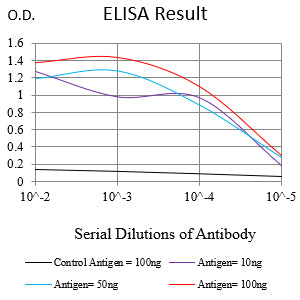


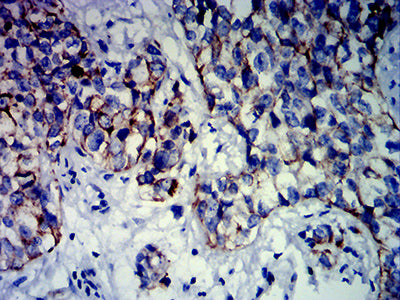
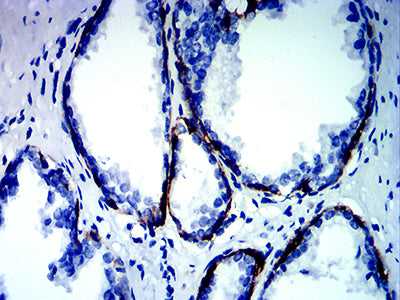
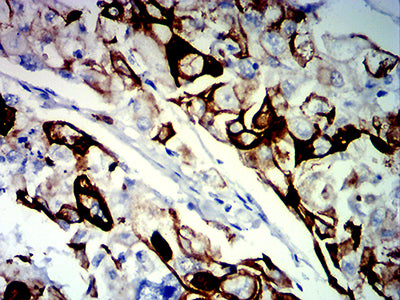
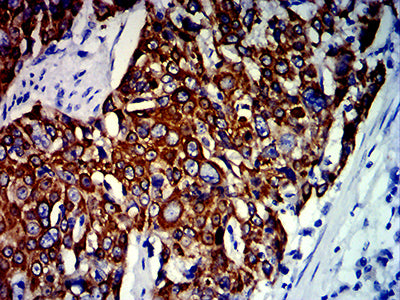
| WB | 1/500 - 1/2000 | Human,Mouse,Rat |
| IF | 咨询技术 | Human,Mouse,Rat |
| IHC | 1/200 - 1/1000 | Human,Mouse,Rat |
| ICC | 技术咨询 | Human,Mouse,Rat |
| FCM | 1/200 - 1/400 | Human,Mouse,Rat |
| Elisa | 1/10000 | Human,Mouse,Rat |
| Aliases | K13; CK13; WSN2 |
| Entrez GeneID | 3860 |
| clone | 7D7B3 |
| WB Predicted band size | 49.5kDa |
| Host/Isotype | Mouse IgG1 |
| Antibody Type | Primary antibody |
| Storage | Store at 4°C short term. Aliquot and store at -20°C long term. Avoid freeze/thaw cycles. |
| Species Reactivity | Human |
| Immunogen | Purified recombinant fragment of human KRT13 (AA: 104-458) expressed in E. Coli. |
| Formulation | Purified antibody in PBS with 0.05% sodium azide |
+ +
以下是关于KRT13抗体的3篇代表性文献,供参考:
1. **文献名称**:*KRT13 Downregulation as a Prognostic Marker of Oral Squamous Cell Carcinoma*
**作者**:Chen Y, et al.
**摘要**:本研究利用KRT13抗体通过免疫组化分析口腔鳞状细胞癌(OSCC)患者组织样本,发现KRT13表达下调与肿瘤侵袭性及患者预后不良显著相关,提示其可作为OSCC的潜在预后标志物。
2. **文献名称**:*Keratin 13 Is a Novel Diagnostic and Prognostic Biomarker in Esophageal Squamous Dysplasia*
**作者**:Wang L, et al.
**摘要**:通过KRT13抗体检测食管鳞状上皮异型增生组织,发现KRT13在早期癌变中表达缺失,可作为区分良性病变与恶性转化的特异性标志物,为食管癌早期诊断提供依据。
3. **文献名称**:*Immunohistochemical Characterization of Keratin 13 in Ocular Surface Disorders*
**作者**:Gipson IK, et al.
**摘要**:研究使用KRT13抗体评估角膜和结膜上皮的角蛋白表达模式,发现其在干眼症等眼表疾病中表达异常,提示KRT13可能参与眼表屏障功能的维持。
---
**备注**:若需获取全文,建议通过PubMed或ResearchGate搜索标题,部分文献可能需通过机构访问权限下载。如需更早期研究或特定技术细节(如抗体克隆号、实验方法),可进一步补充说明。
KRT13 (Keratin 13) is a type I intermediate filament protein encoded by the *KRT13* gene, primarily expressed in non-keratinizing stratified squamous epithelia, such as those in the oral mucosa, esophagus, and cervix. As a structural component, it contributes to epithelial integrity, mechanical stability, and cellular differentiation. KRT13 antibodies are immunological tools targeting this protein, widely used in research and diagnostics to study epithelial biology and pathology.
In normal tissues, KRT13 is a marker for differentiated mucosal epithelial cells. Its expression is often reduced or lost in squamous cell carcinomas (e.g., esophageal, oral), making it a potential biomarker for malignancy progression. Antibodies against KRT13 aid in distinguishing benign lesions from malignant tumors in histopathological analyses. For instance, loss of KRT13 immunoreactivity is associated with poor differentiation in esophageal cancer.
These antibodies are also employed in studying epithelial disorders, such as white sponge nevus (linked to *KRT13* mutations), and in exploring tissue-specific differentiation pathways. Common applications include immunohistochemistry, immunofluorescence, and Western blotting, supporting both clinical diagnostics and mechanistic research in epithelial diseases.
×